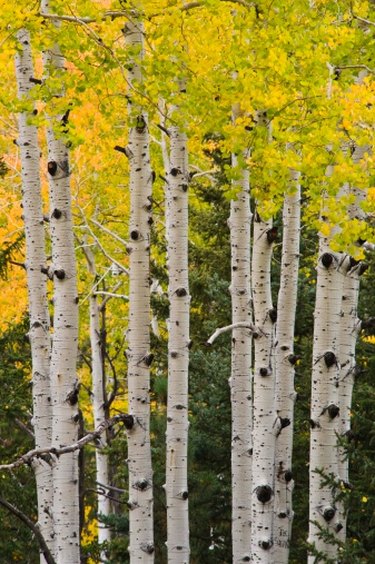
Soaring white birch trees thrive in northern climates, creating a stunning landscape of white trunk columns. For interior spaces, birch trees manifest a natural woodland feel. Birch trees need regular mulching and deep watering so that water saturates the tree roots. The tree also needs to receive full sunshine on its leaves for much of the day for the soil to remain cool and moist. Growing the tree indoors makes these requirements less difficult to meet: You can place the tree in large rooms filled with windows that illuminate the leaves and tree top but do not dry out the soil.
Paper Birch
Video of the Day
Paper birch trees are the typical birch tree type. This birch tree species changes into a silver-white bark. Birch tree bark peels off in thin, scroll-like peels, which makes a beautiful textured column. The trees grow naturally in the Northern U.S., in zones 2 and 5. Because the birch tree can grow up to 70 feet tall, for interior design you can grow the tree partially inside -- like up to 25 feet tall -- and then replant the tree outdoors.
Video of the Day
White Barked Himalayan Birch
The white barked Himalayan birch has the most pure white bark color of all birch species. The stark white trunks make brilliant columns in a hotel lobby, large home or in an entry foyer. Like the paper birch, the bark peels as the tree ages. Smaller in size than other species, the white Himalayan reaches up to 40 feet tall with a wider spread. This wider, triangular tree top structure can create a canopylike effect indoors if there are more than one or two trees.
European White Birch
While the paper birch has a purer white color and black bark detailing, the European white birch develops its white color earlier, from brown. The European white birch lives for 10 to 20 years without a spray program in Ohio. Because the bark colors later, the canoe, or paper, birch is less commonly grown in nurseries.
Silver Birch
Silver birch is another species of birch that has distinctive bark used in decorating. This birch does not have peeling bark like other birch varieties. Instead the tree turns black around injuries, splits, scars or cracks in the trunk as it ages. The leaves of silver birch are smaller than those of other birch varieties, and the serrated margins are deeper. The tree is pyramidal in shape, but the tips of branches turn downward to give silver birch a softer appearance. Silver birches grow well in zones 3 through 6.